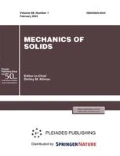Abstract—
The spatial 3D gyrocompass, developed by the author to control the angular position of an orbiting spacecraft (SC), makes it possible to create an orientation system based on it, operating both from an Earth orientation device (EOD), and from an astro sensor (AS), or any another sensor without changing the basic structure of the algorithm. Such a system can be called a hybrid orientation system (HOS). The development of HOS is relevant in connection with the growth of the Customer’s requirements for the universalization of the development of SC control systems. The use of HOS makes it possible to reduce the load on the on-board computer, simplify ground testing of the SC control system, and improve the quality of SC control in flight due to a decrease in the branching of orientation algorithms. This article presents working algorithms, derivation of the main relations, and modeling results.
Similar content being viewed by others
REFERENCES
I. N. Abezyaev, “Gyro-compass for orbital spacecraft,” RF Patent No. 2 597 018, Byull. Izobret., No. 24 (2016).
K. A. Boyarchuk, V.V. Vilenskiy, V.Yu. Grishin, et al., “The system of orientation and stabilization of the "Condor-E” spacecraft,” in Proceedings of the Section 22 Named After Academician V.N. Chelomey of XXXVIII Scientific Conference on Cosmonautics (NPO Mashinostroyenia, Reutov, 2014), Vol. 22, pp. 408–424.
I. N. Abezyaev, A. V. Andreyanenkova, P. E. Velichko, et al., “Method for restoring the heading orientation of a spacecraft using the orbital gyrocompass,” Inzh. Zh.: Nauka Innovats., No. 5(65), 1–8 (2017). https://doi.org/10.18698/2308-6033-2017-5-1621
I. N. Abezyaev, P. E. Velichko, A. A. Karpunin, et al., “Development of the algorithm of the spacecraft programmed yaw turns with the use of orbital gyrocompass,” AIP Conf. Proc. 2171 (1), 060009 (2019).
A. I. Tkachenko, “Attitude determination of a spacecraft using a vertical sensor,” Kosm. Nauka Tekhnol. 22 (2), 22–28 (2016). https://doi.org/10.15407/knit2016.02.022
F. G. Major, “The mechanical gyrocompass,” in Quo Vadis: Evolution of Modern Navigation (Springer, New York, 2014), pp. 259–285.
D. B. Reid, “Orbital gyrocompass evolution,” GON Intertial Sens. Syst. (ISS) 20, 149–170 (2016). https://doi.org/10.1109/InertialSensors.2016.7745672
Author information
Authors and Affiliations
Corresponding author
Additional information
Translated by M. Katuev
About this article
Cite this article
Abezyaev, I.N. HYBRID ORIENTATION SYSTEM FOR ORBITAL SPACECRAFT. Mech. Solids 56, 471–477 (2021). https://doi.org/10.3103/S0025654421040026
Received:
Revised:
Accepted:
Published:
Issue Date:
DOI: https://doi.org/10.3103/S0025654421040026




